| Author |
Message |
Rodolfo Martínez

|
 Posted: Wed 21 Feb, 2007 12:23 pm Post subject: What knid of armour are wearing this guys? Posted: Wed 21 Feb, 2007 12:23 pm Post subject: What knid of armour are wearing this guys? |
 |
|
Hello to all,
I have some paintings with french gendarmes, and i´m not sure what kind of armour are them using, or they really used in combat.
I´m not sure how reliable paintings are, but looking their helmets and the fact that they are very similar, maybe they are based in a true kind of armour wich i don´t know.
Do you know wich style of armour are they using in the pics, or wich kind of armour they prefered during the frist half of the XVI century?
Thanks.
 Attachment: 11.64 KB Attachment: 11.64 KB
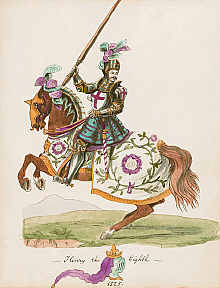
 Attachment: 122.63 KB Attachment: 122.63 KB
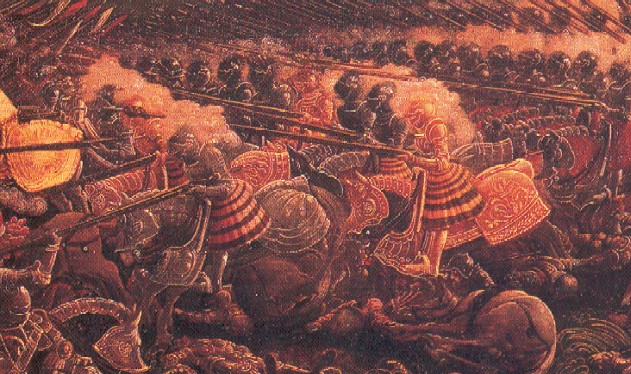
¨Sólo me desenvainarás por honor y nunca me envainarás sin gloria¨
|
|
  |
 |
Richard Fay

|
 Posted: Wed 21 Feb, 2007 1:31 pm Post subject: Posted: Wed 21 Feb, 2007 1:31 pm Post subject: |
 |
|
Hi Rodolfo!
I would say probably sixteenth-century full armour with cloth bases (the pleated "skirts" worn over the armour). I think the top illustration is actually based on an illustration of an English knight (possibly Henry VIII) from a Dutch manuscript of the early sixteenth century. If you look at the image below, the mounted warrior has a similar armour, and even pose, to the illustration you posted. Note the cloth base. This particular detail is also present in the painting you posted. I see no reason to believe the painting shows anything other than a battle. Full armour is also shown in depictions of the battle of the spurs of 1513. The French cavalry decided to quit the field shortly after the English cavalry charged, with the English in hot pursuit. (Maybe it wasn't really much of a battle, but it was a battle.)
 Attachment: 20.18 KB Attachment: 20.18 KB
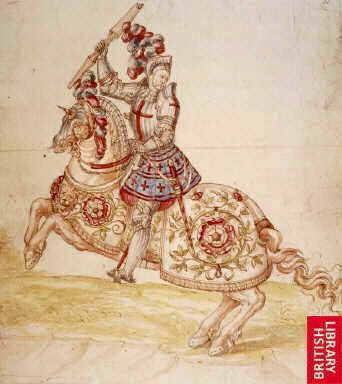
A mounted knight.
Copyright © The British Library Board
"I'm going to do what the warriors of old did! I'm going to recite poetry!"
Prince Andrew of Armar
|
|
 |
 |
Richard Fay

|
 Posted: Wed 21 Feb, 2007 2:00 pm Post subject: Posted: Wed 21 Feb, 2007 2:00 pm Post subject: |
 |
|
Hello again!
In case it helps narrow down what kind of armour is shown in the illustrations Rodolfo posted, I found another painting with roughly similar armour. The mounted warriors in the detail from "The Battle of Alexander" by Albrecht Altdorfer, 1529, also wear cloth bases. They also appear to be wearing full armour in battle.
I also found a painting of the Battle of the Spurs (or Battle of Guinegate) of 1513. I don't know the actual date of the painting, but note again that some of the armoured warriors wear cloth bases over what appears to be full armour. This armour is definitely worn in battle in the painting.
 Attachment: 74.67 KB Attachment: 74.67 KB

The Battle of Alexander (detail), 1529.
 Attachment: 97.94 KB Attachment: 97.94 KB
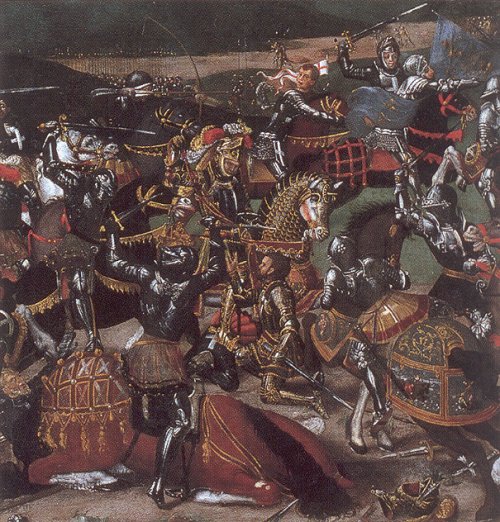
The Battle of the Spurs (or Battle of Guinegate) 1513.
"I'm going to do what the warriors of old did! I'm going to recite poetry!"
Prince Andrew of Armar
|
|
 |
 |
Rodolfo Martínez

|
 Posted: Wed 21 Feb, 2007 2:41 pm Post subject: Posted: Wed 21 Feb, 2007 2:41 pm Post subject: |
 |
|
Thanks Richard, Do you know if those gendarmes still used the ¨Milanese¨ style (Like the armour at Glasgow) and ¨Gothic¨ in the first half of the XVI century, or they used later like the armours of the picture?
Thanks
 Attachment: 16.26 KB Attachment: 16.26 KB
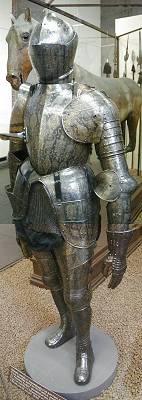
 Attachment: 52.04 KB Attachment: 52.04 KB
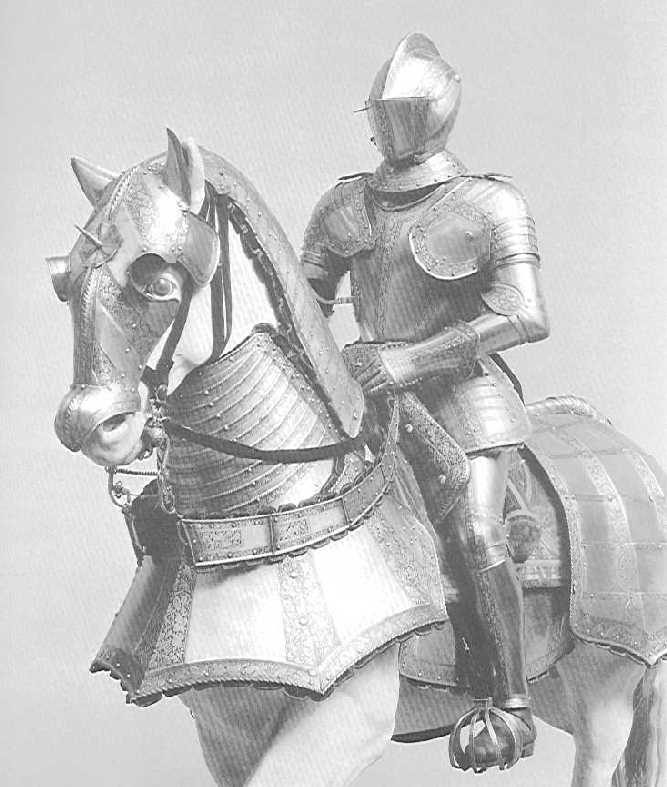
This armour dates from 1560, but there are earlier examples of the style. 1540, maybe 1520.
¨Sólo me desenvainarás por honor y nunca me envainarás sin gloria¨
|
|
  |
 |
Richard Fay

|
 Posted: Wed 21 Feb, 2007 2:43 pm Post subject: Posted: Wed 21 Feb, 2007 2:43 pm Post subject: |
 |
|
Hello again!
Here's an interesting Greenwich armour for the field and tournament dated 1527. The fact that it was for the field as well as tournament implies that it could indeed be used in battle. It is a garniture, which means it has exchange and reinforce pieces to enable it's use in tournament as well as battle. I think the gilding is an interesting comparison to at least one figure in the painting Rodolfo posted. this armour was made in England, but was presented to the French ambassador François de La Tour d'Auvergne. The armour is now in the Metropolitan Museum of Art.
 Attachment: 23.6 KB Attachment: 23.6 KB
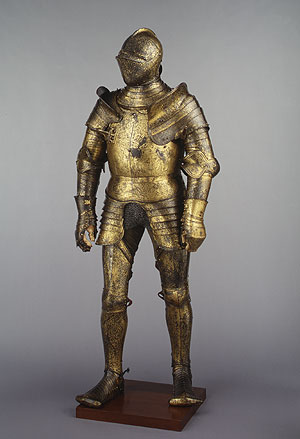
English Armor for Field and Tournament, dated 1527.
Copyright © 2000–2006 The Metropolitan Museum of Art.
"I'm going to do what the warriors of old did! I'm going to recite poetry!"
Prince Andrew of Armar
|
|
 |
 |
|
Lafayette C Curtis
|
 Posted: Wed 21 Feb, 2007 7:26 pm Post subject: Posted: Wed 21 Feb, 2007 7:26 pm Post subject: |
 |
|
Well...I suppose the gendarmes would have used the latest models, for no other reason than that full harnesses were individually tailored for the user. But this is a sweeping statement and doesn't take account of the fact that some people might have preferred to order armors along the older models (though the armors themselves would have been new) for the sake of romanticism and the like.
Or the freak probability of somebody finding a predecessor whose body measurements were uncannily similar to him, and hence the armor.
|
|
  |
 |
Hisham Gaballa

|
 Posted: Thu 22 Feb, 2007 12:30 am Post subject: Posted: Thu 22 Feb, 2007 12:30 am Post subject: |
 |
|
There is a similar armour (also made for Henry the VIII) in the Royal Armouries, click on the thumbnail please:

Copyright © 1988 "Arms and Armour of the Medieval Knight" by David Edge and John Miles Paddock .
Last edited by Hisham Gaballa on Thu 22 Feb, 2007 12:12 pm; edited 1 time in total
|
|
  |
 |
Rodolfo Martínez

|
 Posted: Thu 22 Feb, 2007 7:58 am Post subject: Posted: Thu 22 Feb, 2007 7:58 am Post subject: |
 |
|
Those are excellent armours 
Do you know, then if the Italian style during this first half of XVI century, in someway stoped the production or something else? Because there aren´t many field armours of the italic style during this period.
Thanks
¨Sólo me desenvainarás por honor y nunca me envainarás sin gloria¨
|
|
  |
 |
Richard Fay

|
 Posted: Thu 22 Feb, 2007 9:05 am Post subject: Posted: Thu 22 Feb, 2007 9:05 am Post subject: |
 |
|
| Rodolfo Martínez wrote: |
Do you know, then if the Italian style during this first half of XVI century, in someway stoped the production or something else? Because there aren´t many field armours of the italic style during this period.
Thanks |
Rodolfo,
I think what you may be observing is the fusion of the two styles, Italian and German, in the sixteenth century, although there was an apparent decline in the quality of armours made in the Italian armour-production centres. The fusion of the styles led, in part, to the "Maximilian" style. It seems that the main armour-producing centres of the fifteenth century continued production into the sixteenth. Let me post some excerpts from Claude Blair's European Armour Circa 1066 to Circa 1700. Perhaps this will be a assistance in answering some of your questions:
| Claude Blair wrote: |
Most of the armour producing centres mentioned in the last chapter (Milan, Landshut, Innsbruck, Nuremberg, and Augsburg) continued to operate in the 16th century. In Milan, the Missaglias were supplanted in their position of pre-eminence by the Negroli who, although their name is always connected with the embossed decoration of armour, were also merchants carrying out an export trade in all types. A general falling-off in the quality of Italian armour occurred in the second half of the century and Milan finally took second place to the South German centres while, within Italy, an increasingly powerful challenge came from Brescia. During the same period the Negroli were, in their turn supplanted by Pompeo della Chiesa of Milan who likewise carried on a very considerable export trade. In Germany many great armourers were working during the 16th century: Lorenz Helmschmied, who did not die until 1516, was followed by his equally famous son Koloman (1471-1532), who was in turn followed by his son Desiderius (1513 - c. 1578). Other important German armourers who should be mentioned are Matthaus Frauenpreiss the Elder (ob. 1549) and Anton Peffenhauser (1525-1603), both of Augsburg, Kunz Lochner the Younger (c. 1510-1567) of Nuremberg and Wolfgang (ob. 1563) and Franz (ob. c. 1580) Grossschedel of Landshut.
The style of armour in use during the first thirty years of the 16th century, and more particularly that decorated with vertical fluting is usually termed "Maximilian" by modern students, although there is no evidence to show that the Emperor was responisble for its introduction. With little doubt it was in fact produced by the fusion of the German and Italian styles described above (the fifteenth-century Italian and German, or "Gothic", styles), the main manifestations of which were the whole-hearted adoption by the Germans of the burly rounded Italian forms and the more limited adoption by the Italians of fluted decoration. Armours with smooth surfaces were however used as widely during the Maximilian period as the fluted type, and were indeed the most popular kind outside Germany.
In Italy fluted armour seems to have gone out of fashion by c. 1520 but remained in regular use in Germany until the 1530's and is occasionally found even later
|
And here's an excerpt from The Complete Encyclopedia of Arms & Weapons, edited by Leonid Tarassuk and Claude Blair:
| Quote: |
The two main "schools" that had the greatest influence on all European armorers were the Northern Italian and the German. The former was characterized by it smooth finish and round surfaces, while the latter was renowned for its Gothic styilization which showed particularly in elaborate curves ending in cusps, rippling, fluting, etc., and, when it reached its peak toward the end of the 15th century, in an elegant slenderness of line. Around the beginning of the 16th century there was a certain tendency for the two styles to blend, the typically rounded lines of the Italian armor being adopted in Germany while the German system of fluting was sometimes used in Italy.
From about 1510-30 the so-called Maximilian style of armor came into use, although it was not to get this name until some 19th-century collectors decided that the style must have been introduced by the emperor Maximilian. Its characteristic features were large rounded shaped and radiating flutings on all surfaces except the leg armor. The later examples had quite narrow flutes, set close together. This style was widely used, especially in Germany, although fluted armor never superseded smooth-surfaced armor, which always remained more popular in the rest of Europe.
Field armor A type of armor used by heavy cavalry in the 15th and 16th centuries. It was a complete suit of armor, matched by a horse armor with a steel-plated saddlebow giving additional protection to the horseman. Head protection consisted of a sallet with a separate bevor, an armet, or a close helmet; in the second half of the 16th century, a lighter helmet, the burgonet, with or without a bevor, was often preferred. |
And here's a much-simplified version of the same point regarding the fusion of styles from Arms and Armour of the Medieval Knight by David Edge and John Miles Paddock:
| Quote: |
The characteristic styles of German and Italian armourers tended to no longer be so clear-cut and immediately recognizable; the Germans adopted rounded proportions reminiscent of Italian armour while the Italians began to employ structural features with technical innovations hitherto the province of their German rivals.
Full armours of heavy plate continued to be produced throughout the sixteenth century, but increasingly their use became restricted to the tournament rather than battlefield.
The two main centres of armour manufacture remained Italy and Germany, but to an increasing exent lesser centres managed to establish themselves, either to serve local or international need, or as a direct result of royal patronage by kings, princes and their courts anxious to emulate thier neighbours and impress the world at large. |
The field armour mentioned above would be akin to the Greenwich armour I posted earlier. The Greenwich armour had pieces of exchange and reinforcements that could be used for the joust.
I hope these excerpts helped to answer your questions.
Stay safe!
"I'm going to do what the warriors of old did! I'm going to recite poetry!"
Prince Andrew of Armar
|
|
 |
 |
Rodolfo Martínez

|
 Posted: Thu 22 Feb, 2007 2:11 pm Post subject: Posted: Thu 22 Feb, 2007 2:11 pm Post subject: |
 |
|
Thanks Richard, you cleared the Italic style doubt, but the next quote is a bit confusing for me:
| Quote: | | Head protection consisted of a sallet with a separate bevor, an armet, or a close helmet; in the second half of the 16th century, a lighter helmet, the burgonet, with or without a bevor, was often preferred. |
Weren´t burgonets most used by infantry, while heavy cavalry (Wich used it too) prefered close helmets during the second half of the XVI century?
Thanks
¨Sólo me desenvainarás por honor y nunca me envainarás sin gloria¨
|
|
  |
 |
Richard Fay

|
 Posted: Thu 22 Feb, 2007 2:58 pm Post subject: Posted: Thu 22 Feb, 2007 2:58 pm Post subject: |
 |
|
| Rodolfo Martínez wrote: | Thanks Richard, you cleared the Italic style doubt, but the next quote is a bit confusing for me:
| Quote: | | Head protection consisted of a sallet with a separate bevor, an armet, or a close helmet; in the second half of the 16th century, a lighter helmet, the burgonet, with or without a bevor, was often preferred. |
Weren´t burgonets most used by infantry, while heavy cavalry (Wich used it too) prefered close helmets during the second half of the XVI century?
Thanks |
The excerpt I posted from The Complete Encyclopedia of Arms & Weapons suggests that burgonets were also popular with cavalry. I believe that section is describing armour used by heavy cavalry. There were "closed burgonets" in the 17th century.
Here's what it says about burgonets in the same work:
| Quote: |
burgonet A type of light helmet, worn by infantry and light cavalry in Europe from about 1520 to the end of the 16th century. An open helmet with a pointed peak, called the FALL, and a neck guard, the burgonet was fitted with hinged cheekpieces. The skull was generally made in two interlocking halves which were then rivetted and hammered together along the comb. In better-quality helmets, the skull was made of one plate. The basic shape of the skull was hemispherical, broken only by the comb which tended to assume more and more exaggerated proportions during the third quarter of the century. There were, however, some examples of ogival skulls, with or without a pointed "spur" on the apex. The fall projected from the skull over the face, and the neck guard projected over the nape, both being reinforced by a rim along their edges. The cheekpieces consisted of contoured plates, often shaped in the center to accomodate the ears, and pierced with ventilation holes. The cheekpieces, too, had border rims and could be closed under the chin with buckled straps.
The closed type of burgonet often included a detachable BEVOR or buffe. In another style, the cheekpieces were enlarged to cover the face, thus forming the bevor. Two parts of the bevor were kept in closed poistion by a strap around the neck or by hasps and pierced lugs. The FALLING BUFFE, sometimes termed "Hungarian bevor", has two pivoted collapsible lames protecting the face; they could fall to open the face when retaining studs were pressed. A rare variation of the burgonet had a skull with a central comb flanked by a lower one on each side; it was nicknamed the "three-combed burgonet".
During the first half of the 17th century, two types of burgonet resembled in appearance and construction the CLOSE HELMET with gorget plates. Both types had the bevor and one-piece visor pivoted on the sides of the skull (like early close helmets), but they were also provided with a burgonet peak (fall) atttached to the same side pivots. One of these types is often termed the "Savoyard" burgonet, its name deriving from the fact that it was standard issue to the men of the Duke of Savoy's army...
Another burgonet resembling close helmets was also used with cuirassier armour... |
And this is from Claude Blair's European Armour Circa 1066 to Circa 1700:
| Claude Blair wrote: |
The headpiece par excellence of the infantry and light cavalry throughout the 16th century was the burgonet. In its most characteristic form this is a close-fitting open helmet - covering the cheeks but leaving the front of the face exposed - with a pointed peak (fall), sometimes pivotted at the sides. The cheekpieces are usually formed of separate plates, hinged at the rear and tied together with a thong at the chin, or, more rarely, overlapping and secured by a catch as on an armet.
On a number of German and Flemish burgonets of the last quarter of the century the cheekpieces completely cover the face except for cut-outs over the eyes and occasionally over the nose and mouth.
In addition to the buffe, or sometimes as an alternative to it, some burgonets have a barred face-guard, often detachable.
Another form of headpiece in wide use from c. 1520 is usually classified as a close-helmet, although, in fact, it is a cross between a close-helmet and a burgonet. Its construction is that of a close-helmet but instead of visor and upper-bevor it has a fall and a falling-buffe that forms part of the bevor. |
From what I've read, the burgonet may indeed be more appropriate for light cavalry. It was certainly used by the infantry. However, there were those "hybrid" forms that were a cross between the close-helmet and the burgonet that might have been used by the heavy cavalry. There is, for instance, a close-helmet of burgonet form shown in the drawings in the back of Blair's European Armour that was made at Greenwich for William Herbert, First Earl of Pembroke, circa 1550.
I hope this helped to clarify things a bit.
By the way, below I've posted the drawing of the burgonet and buffe of Sir Henry Lee, Greenwich, circa 1585. This is originally from Blair's European Armour.
Stay safe!
 Attachment: 3.92 KB Attachment: 3.92 KB
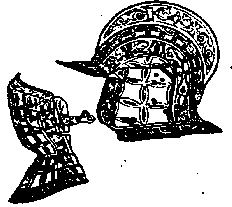
Burgonet and buffe of Sir Henry Lee, Greenwich, circa 1585.
"I'm going to do what the warriors of old did! I'm going to recite poetry!"
Prince Andrew of Armar
|
|
 |
 |
Rodolfo Martínez

|
 Posted: Thu 22 Feb, 2007 7:09 pm Post subject: Posted: Thu 22 Feb, 2007 7:09 pm Post subject: |
 |
|
Nice helmet, it´s a shame that later versions became uglier...
I was wondering if that burgonet has something to do with sallets...
I haven´t seen fluted armours dating from 1540 and on, Do you know if that fashion was replaced by the peascod armours fashion?
The following armours are Italian and German styles from second half of XVI century, Aren´t them very similar?
 Attachment: 42.76 KB Attachment: 42.76 KB
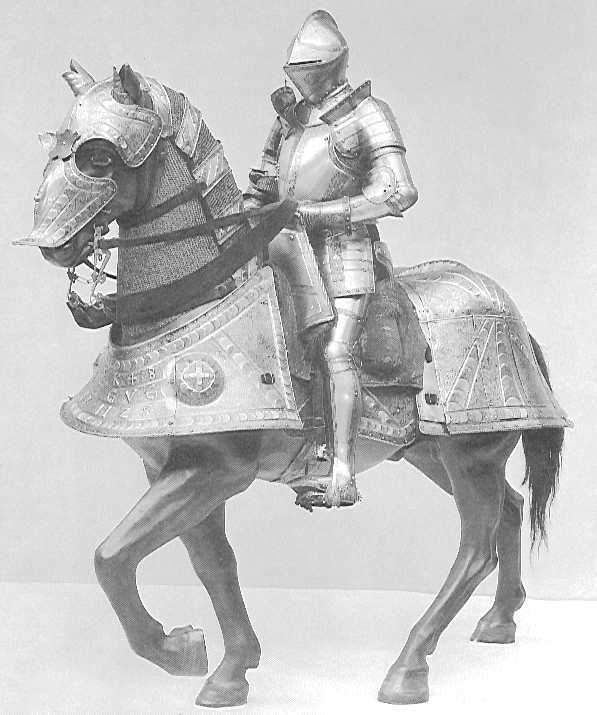
German horse armour ca.1550
 Attachment: 10.03 KB Attachment: 10.03 KB
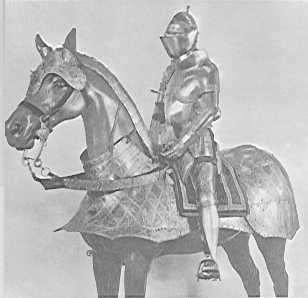
Another German armour dating around 1540-1550
 Attachment: 48.98 KB Attachment: 48.98 KB
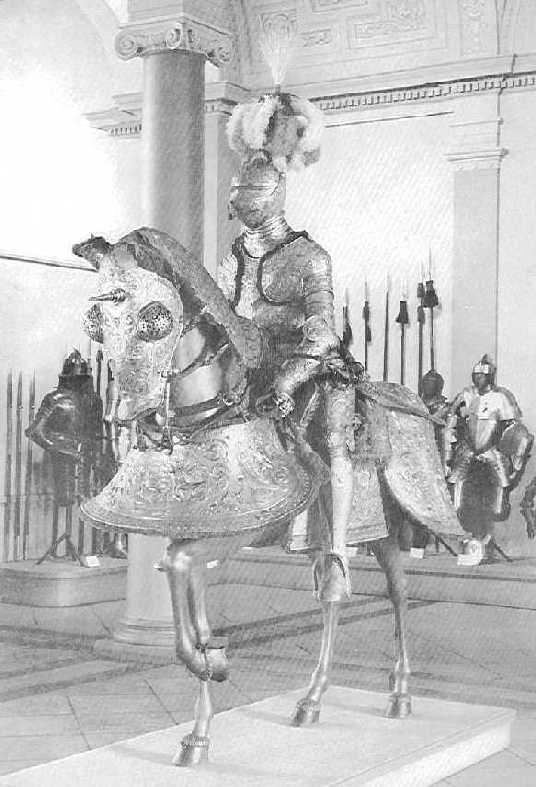
Italian harness, ca.1560 (Name Mistaken :/)
 Attachment: 10.03 KB Attachment: 10.03 KB
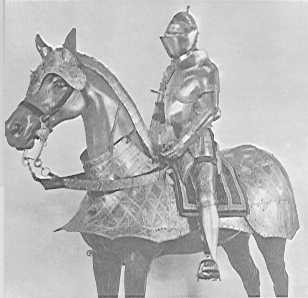
German armour. C. 1551
¨Sólo me desenvainarás por honor y nunca me envainarás sin gloria¨
|
|
  |
 |
Rodolfo Martínez

|
 Posted: Thu 15 Mar, 2007 10:23 am Post subject: Posted: Thu 15 Mar, 2007 10:23 am Post subject: |
 |
|
Hello again,
I was browsing around and i found that by that time (First half of XVI century) Maximilian was the predominant style, so, Do you know why most armours are painted as non fluted suits? Was any othe style in use?
Thanks
¨Sólo me desenvainarás por honor y nunca me envainarás sin gloria¨
|
|
  |
 |
|
|
You cannot post new topics in this forum
You cannot reply to topics in this forum
You cannot edit your posts in this forum
You cannot delete your posts in this forum
You cannot vote in polls in this forum
You cannot attach files in this forum
You can download files in this forum
|
All contents © Copyright 2003-2024 myArmoury.com — All rights reserved
Discussion forums powered by phpBB © The phpBB Group
Switch to the Basic Low-bandwidth Version of the forum
|

